digital signal processing - notes 2 - vector spaces
contents
discrete signal vectors
- a generic discrete signal:
- \( x[n] = …,1.23, -0.73, 0.89, 0.17, -1.15, -0.26,… \)
- set of ordered number sequence
- four classes of signals
- finite length
- infinite length
- periodic
- finite support
- digital signal processing:
- signal analysis
- signal synthesis
- number sets:
- \( \mathbb{N} \): natural numbers \( [1,\infty) \)
- whole numbers \( [0,\infty) \)
- \( \mathbb{Z} \): integers
- \( \mathbb{Q} \): rational numbers
- inclusive of recurring mantissa
- \( \mathbb{P} \): irrational numbers
- non-repeating and non-recurring mantissa
- \( \pi \) value, \( \sqrt{2} \)
- \( \mathbb{R} \): real numbers (everything on the number line)
- includes rational and irrational numbers
- \( \mathbb{C} \): complex numbers
- includes real and imaginary numbers
- \( \mathbb{N} \): natural numbers \( [1,\infty) \)

fig: number sets
vector space framework:
- justification for dsp application:
- common framework for various signal classes
- inclusive of continuous-time signals
- easy explanation of Fourier Transform
- easy explanation of sampling and interpolation
- useful in approximation and compression
- fundamental to communication system design
- common framework for various signal classes
- paradigms for vector space application to discrete signals
- object oriented programming
- the instantiated object can have unique property values
- but for a given object class, the properties and methods are the same
- lego
- various unit blocks, same and different
- units assembled in different ways to build different complex structures
- similarly, a complex signal is broken down into a combination of basis vectors for analysis
- object oriented programming
- key takeaways
- vector spaces are general objects
- vector spaces are defined by their properties
- once signal properties satisfy vector space conditions
- vector space tools can be applied to signals
vector spaces
- some vector spaces
- \(\mathbb{R}^2\): 2D space
- \(\mathbb{R}^3\): 3D space
- \(\mathbb{R}^N\): N real numbers
-
\(\mathbb{C}^N\): N complex numbers
- \(\ell_2(\mathbb{Z}) \):
- square-summable infinite sequences
- \(L_2([a,b]) \):
- square-integrable functions over interval \([a,b] \)
-
vector spaces can be diverse
- some vector spaces can be represented graphically
- helps visualize the signal for analysis insights
- \(\mathbb{R}^2\): \(\textbf{x} = [x_0, x_1]^T\)
- \(\mathbb{R}^3\): \(\textbf{x} = [x_0, x_1, x_2]^T\)
- both can be visualized in a cartesian system
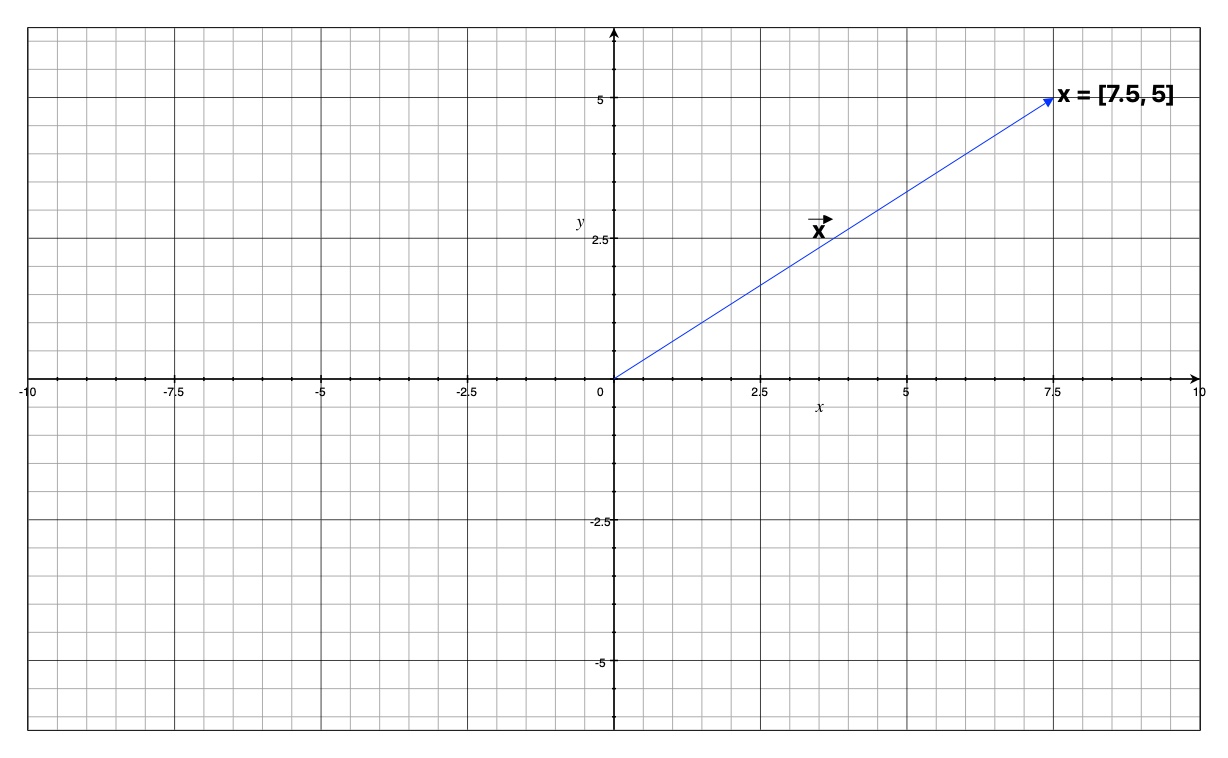
fig: vector in 2D space
- \(L_2([a,b]) \): \( \textbf{x} = x(t), t \in [-1,1] \)
- function vector space
- can be represented as sine wave along time
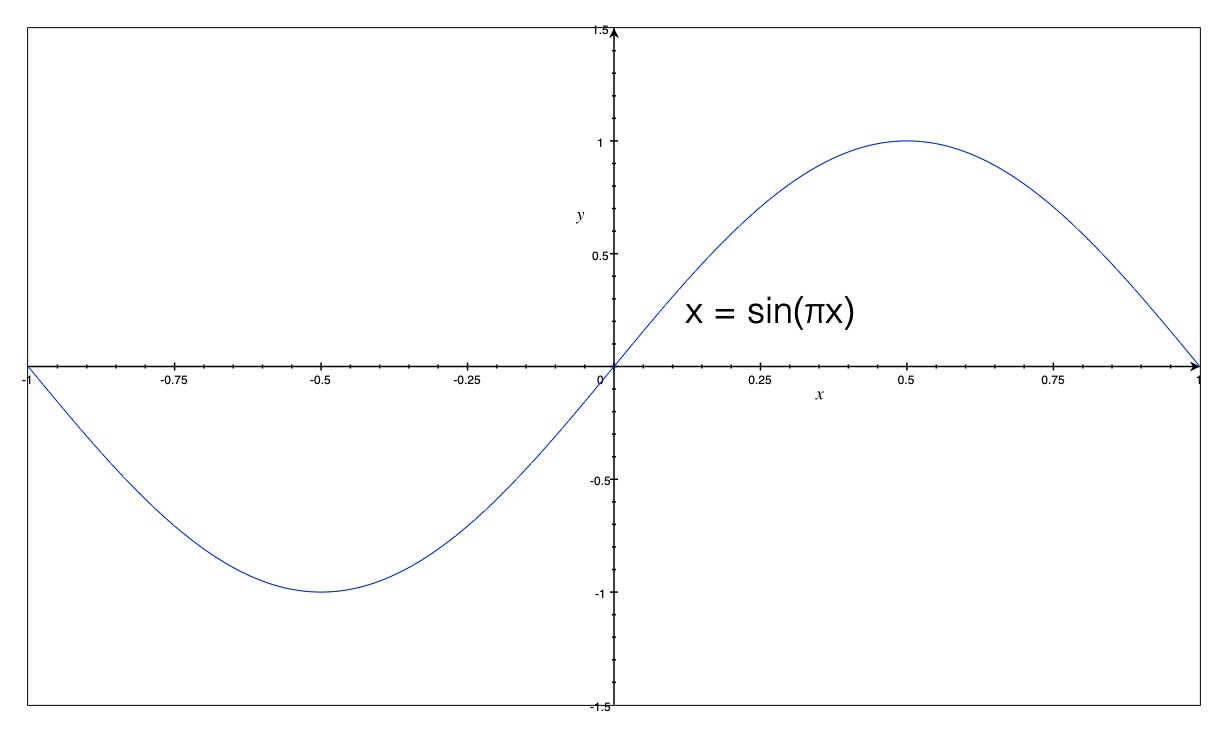
fig: L2 function vector
- others cannot be represented graphically:
- \(\mathbb{R}^N\) for \( N > 3\)
- \(\mathbb{C}^N\) for \( N > 1\)
vector space axioms
- informally, a vector space:
- has vectors in it
- has scalars in it, like \( \mathbb{C} \)
- scalers must be able to scale vectors
- vector summation must work
- formally, \( \forall \text{ } \textbf{x,y,z} \in V, \text{ } and \text{ } \alpha, \beta \in \mathbb{C} \) (\(V\): vector space)
- \(\textbf{x} + \textbf{y} = \textbf{y} + \textbf{x}\)
- commutative addition
- \( (\textbf{x} + \textbf{y}) + \textbf{z} = \textbf{x} + (\textbf{y} + \textbf{z})\)
- distributive addition
- \( \alpha(\textbf{x} + \textbf{y}) = \alpha \textbf{y} + \alpha \textbf{x}\)
- distributive scalar multiplication over vectors
- \( (\alpha + \beta)\textbf{x} = \alpha \textbf{x} + \beta \textbf{x} \)
- distributive vector multiplication over scalers
- \( \alpha(\beta \textbf{x}) = \alpha(\beta \textbf{x})\)
- associative scalar multiplication
- \( \exists \text{ } 0 \in V \text{ } | \text{ } \textbf{x} + 0 = 0 + \textbf{x} = \textbf{x} \)
- null vector, \( 0 \), exists
- addition of \( 0 \) and another vector \(\textbf{x}\) returns \(\textbf{x}\)
- summation with null vector is commutative
- \( \forall \text{ } \textbf{x} \in V \text{ } \exists \text{ } (-\textbf{x}) \text{ } | \text{ } \textbf{x} + (-x) = 0 \)
- an inverse vector exists in vector space such that adding the vector with it’s inverse yields the null vector
- \(\textbf{x} + \textbf{y} = \textbf{y} + \textbf{x}\)
- examples:
- \( \mathbb{R}^N \): vector of N real numbers
- two vectors from this space look like:
- \(\textbf{x} = [x_0, x_1, x_2, … x_N]^T \)
- \(\textbf{y} = [x_0, x_1, x_2, … x_N]^T \)
- the above mentioned rules apply to these vectors and can be verified
- two vectors from this space look like:
- \( L_2[-1,1] \)
- \( \mathbb{R}^N \): vector of N real numbers
inner product
- aka dot product: measure of similarity of two vectors
- \( \langle \cdot, \cdot \rangle: V \times V \rightarrow \mathbb{C} \)
-
takes two vectors and outputs a scaler which indicates how similar the two vectors are
- inner product axioms
- \( \langle x+y, z \rangle = \langle x, z \rangle + \langle y, z \rangle\)
- distributive over vector addition
- \( \langle x,y \rangle = \langle y,x \rangle^* \)
- commutative with conjugation
- \( \langle x, \alpha y \rangle = \alpha \langle x,y \rangle \)
- distributive with scalar multiplication
- when scalar scales the second operand
- \( \langle \alpha x,y \rangle = \alpha^* \langle x,y \rangle \)
- distributive with scalar multiplication
- conjugate scalar if it scaling the first operand
- \( \langle x,x \rangle \geq 0 \)
- self inner product \( \in \mathbb{R}\)
- \( \langle x,x \rangle = 0 \Leftrightarrow x = 0 \)
- if self inner product is 0, then the vector is the null vector
- if \( \langle x,y \rangle = 0 \text{ } and \text{ } x,y \neq 0 \),
- then \( x \) and \( y \) are orthogonal
- \( \langle x+y, z \rangle = \langle x, z \rangle + \langle y, z \rangle\)
-
inner product is computed differently for different vector spaces
- in \( \mathbb{R}^2 \) vector space:
- \( \langle x,y \rangle = x_0y_0 + x_1y_1 = \Vert x \Vert \Vert y \Vert \cos \alpha\)
- where \( \alpha\): angle between \(x\) and \(y\)
- when two vectors are orthogonal to each other
- \( \alpha = 90^{\circ}\), so \( \cos 90^{\circ} = 0 \), so \( \langle x,y\rangle = 0\)
- \( \langle x,y \rangle = x_0y_0 + x_1y_1 = \Vert x \Vert \Vert y \Vert \cos \alpha\)
- in \( L_2[-1,1]\) vector space:
- \( \langle x,y \rangle = \int_{-1}^1 x(t) y(t) dt\)
- norm: \( \langle x,x \rangle = \Vert x \Vert^2 = \int_{-1}^1 \sin^2(\pi t)dt \)
- the inner product of a symmetric and an anti-symmetric function is 0
- i.e. they are orthogonal to each other and cannot be expressed as a factor of the other in any way
- example 1:
- \( x = \sin(\pi t) \) - anti-symmetric
- \( y = 1 - \vert t \vert\) - symmetric
- \( \langle x,y \rangle = \int_{-1}^1 (\sin(\pi t))(1 - \vert t \vert) dt = 0 \)
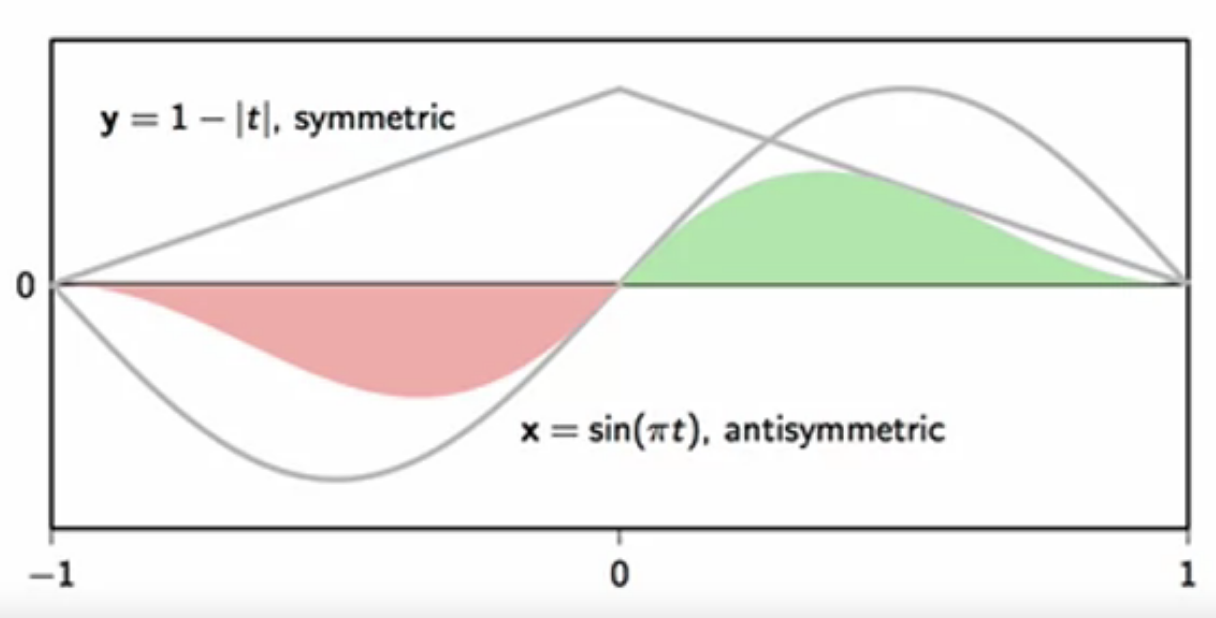
fig: inner product of a symmetric and an anti-symmetric function
- example 2:
- \( x = \sin( 4 \pi t)\)
- \( y = \sin( 5 \pi t)\)
- \( \langle x,y \rangle = \int_{-1}^1 (\sin(4 \pi t))(\sin(5 \pi t)) dt = 0 \)
- \( \langle x,y \rangle = \int_{-1}^1 x(t) y(t) dt\)
norm and distance
- norm of a vector:
- inner product of a vector with itself
- square of the norm (length) of a vector
- \( \langle x,x \rangle = x_0^2 + x_1^2 = \Vert x \Vert ^ 2 \)
- inner product of a vector with itself
- distance between two vectors:
- the norm of the difference of the two vectors
- the distance between orthogonal vectors is not zero
- in \( \mathbb{R}^2 \), norm is the distance between the vector end points
- \( \Vert x - y \Vert \) is the difference vector
- \( \Vert x - y \Vert = \sqrt{(x_0 - y_0)^2 + (x_1 - y_1)^2} \)
- connects the end points of the vectors \(x \) and \(y \)
- see triangle rule of vector addition, and pythagorean theorem
- in \( L_2[-1,1] \), the norm is the mean-squared error:
- \( \int_{-1}^1 \vert x(t) - y(t) \vert^2 dt \)
signal spaces
completeness
- consider an infinite sequence of vectors in a vector space
- if it converges to a limit within the vector space
- then said vector space is “complete”
- also called Hilbert Space
- limiting operation is ambiguous, definition varies from one space to the other
- so some limiting operation may fail and point outside the vector space
- such vector spaces are not said to be complete
common signal spaces
- while vectors spaces can be applied to signal processing
- not all vector spaces can be used for all signals
- different signal classes are managed in different spaces
- \( \mathbb{C}^N \): vector space of N complex tuples
- valid signal space for finite length signals
- vector notation: \(\textbf{x} = [x_0, x_1, … x_N]^T\)
- where \( x_0, x_1 … x_N \) are complex tuples
- also valid for periodic signals
- vector notation: \( \tilde{\textbf{x}}\)
- all operations are well defined and intuitive
- inner product: \( \langle \textbf{x,y} \rangle = \sum_{n=0}^{N-1} x^*[n]y[n] \)
- well defined for all finite-length vectors in \( \mathbb{C}^N\)
- valid signal space for finite length signals
- the inner product for infinite length signals explode in \( \mathbb{C}^N\)
- inappropriate for infinite length signal analysis
- \( \ell_2(\mathbb{Z}) \): vector space of square-summable sequences
- requirement for sequences to be square-summable:
- \( \sum \vert x[n] \vert^2 < \infty\)
- sum of squares of elements of the sequence is less than infinity
- all sequences that live in this space must have finite energy
- “well-behaved” infinite-length signals live in \( \ell_2(\mathbb{Z}) \)
- vector notation: \(\textbf{x} = […, x_{-2}, x_{-1}, x_0, x_1, … ]^T\)
- requirement for sequences to be square-summable:
- lot of other interesting infinite length signals do not live in \( \ell_2 \)
- examples:
- \(x[n] = 1 \)
- \(x[n] = \cos(\omega n) \)
- these have to be dealt with case-by-case
- examples:
basis
- a basis is a building block of a vector space
- a vector space usually has a few basis vectors called bases
- like the lego unit blocks
- any element in a vector space can be
- built with a combination of these bases
- decomposed into a linear combination of these bases
- the basis of a space is a family of vectors which are least like each other
- but they all belong to the same space
- as a linear combination, the basis vectors capture all the information within their vector space
- fourier transform is simply a change of basis
vector families
- \( \{ \textbf{w}^{(k)} \} \): family of vectors
- \( k \): index of the basis in the family
- canonical \(\mathbb{R}^2\) basis: \( \textbf{e}^k\)
- \( \textbf{e}^{(0)} = \begin{bmatrix} 1\\ 0 \end{bmatrix} \text{; } \textbf{e}^{(1)} = \begin{bmatrix} 0\\ 1 \end{bmatrix} \)
- this family of basis vectors is denoted by \( \textbf{e}^k\)
- any vector can be expressed as a linear combination of \( \textbf{e}^k\) in \( \mathbb{R}^2 \)
- \( \begin{bmatrix} x_0 \\ x_1 \end{bmatrix} = x_0\begin{bmatrix} 1 \\ 0 \end{bmatrix} + x_1\begin{bmatrix} 0 \\ 1 \end{bmatrix} \)
- \( \textbf{x} = x_0 \textbf{e}^{(0)} + x_1 \textbf{e}^{(1)}\)
- graphical example:
- \( \begin{bmatrix} 2 \\ 1 \end{bmatrix} = 2\begin{bmatrix} 1 \\ 0 \end{bmatrix} + 1\begin{bmatrix} 0 \\ 1 \end{bmatrix} \)
- \( \textbf{x} = 2 \textbf{e}^{(0)} + 1 \textbf{e}^{(1)}\)
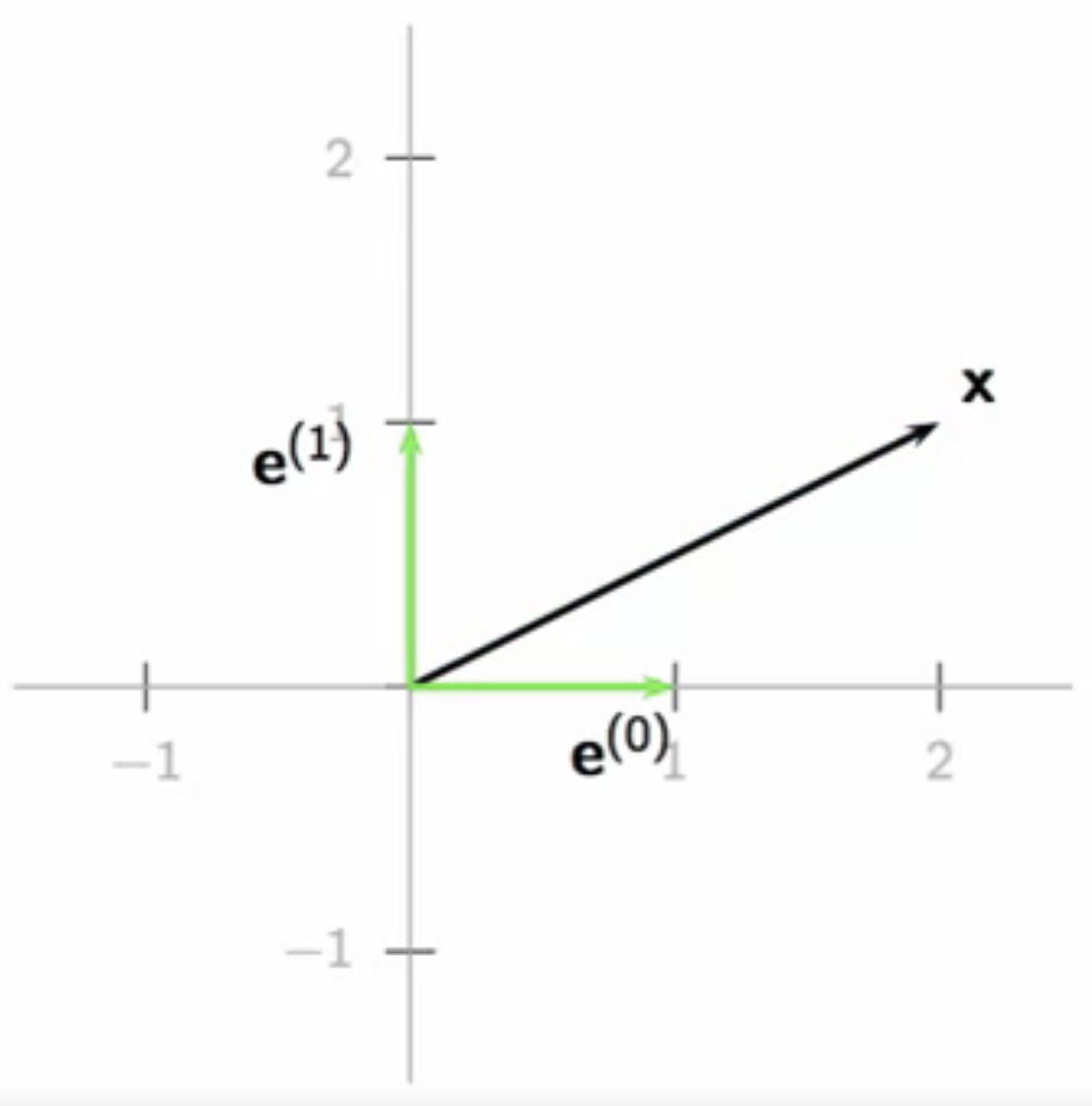
fig: linear combination of canonical \( \textbf{e}^k\) in \(\mathbb{R}^2\)
- non-canonical \(\mathbb{R}^2\) basis example: \( \textbf{v}^k\)
- \( \textbf{v}^{(0)} = \begin{bmatrix} 1\\ 0 \end{bmatrix} \text{; } \textbf{v}^{(1)} = \begin{bmatrix} 1\\ 1 \end{bmatrix} \)
- any vector can be expressed as a linear combination of these vectors in \(\mathbb{R}^2\)
- the coefficients of the bases will be different compared to the canonical bases
- graphical example:
- \( \begin{bmatrix} 2 \\ 1 \end{bmatrix} = \alpha \textbf{v}^{(0)} + \beta \textbf{v}^{(1)} \)
- \( \begin{bmatrix} 2 \\ 1 \end{bmatrix} = \alpha \begin{bmatrix} 1\\ 0 \end{bmatrix} + \beta \begin{bmatrix} 1\\ 1 \end{bmatrix} \)
- by rule of parallelogram vector addition
- \( \alpha = 1 \text{; } \beta = 1\)
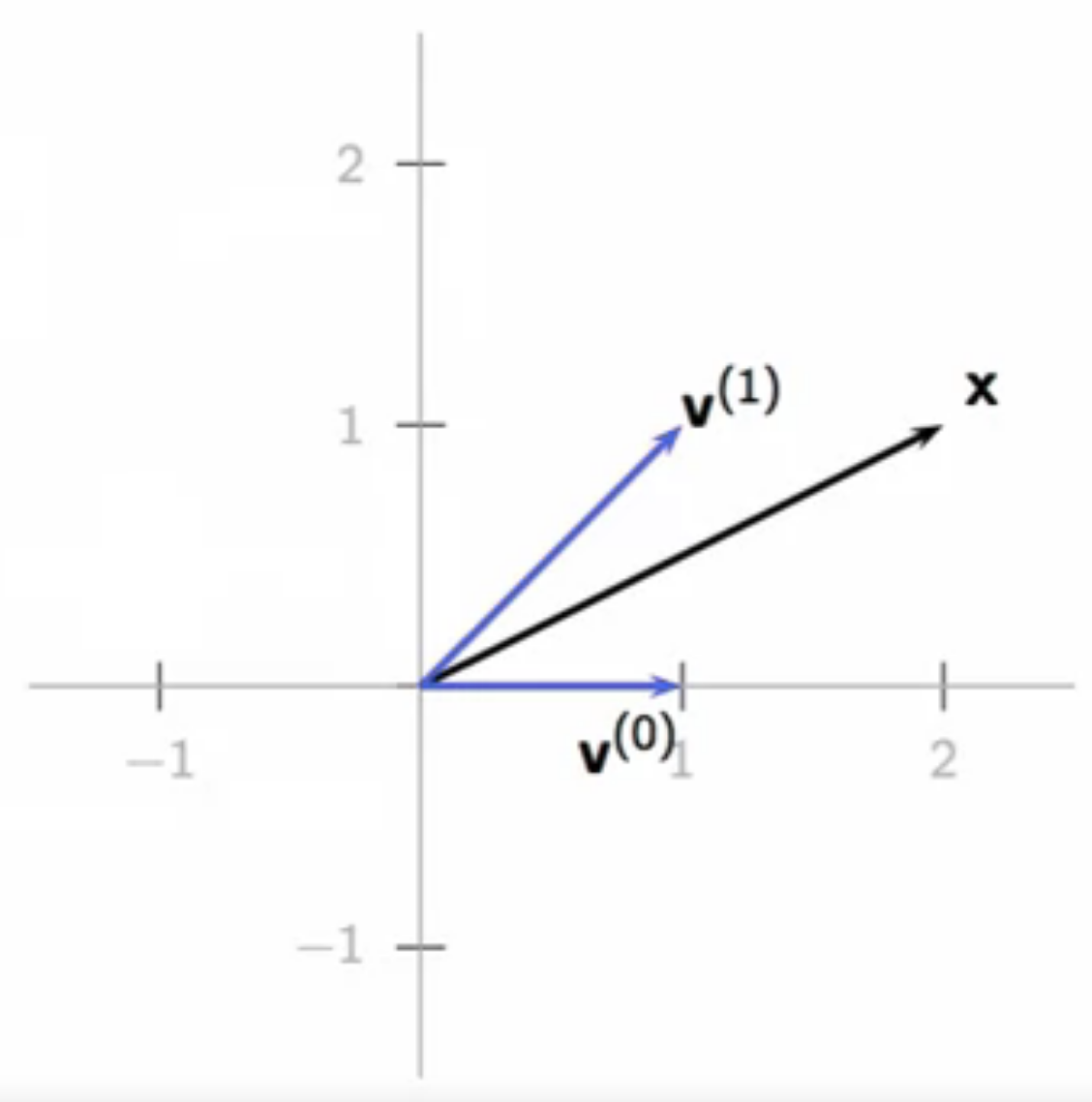
fig: linear combination of non-canonical \( \textbf{v}^k\) in \(\mathbb{R}^2\)
- only vectors which are linearly independent can be the basis vectors of a space
- infinite dimensional spaces bases:
- some limitations have to be applied to obtain basis vectors of infinite dimension
- \( \textbf{x} = \sum_{k=0}^{\infty} \alpha_k \textbf{w}^{(k)} \)
- a canonical basis of \(\ell_2(\mathbb{Z})\)
- \( \textbf{e}^{k} = \begin{bmatrix} .\\.\\.\\ 0\\ 0\\ 1\\ 0\\ 0\\ 0\\ .\\.\\.\\ \end{bmatrix} \), \(k\) -th position, \( k \in \mathbb{Z} \)
- function vector spaces:
- basis vector for functions: \( f(t) = \sum_{k}\alpha_{k}\textbf{h}^{(k)}(t) \)
- the fourier basis for functions over an interval \([-1,1]\):
- \( \frac{1}{\sqrt{2}}, \cos\pi t, \sin\pi t, \cos2\pi t, \sin2\pi t,\cos3\pi t, \sin3\pi t, \ldots \)
- any square-integrable function in \([-1,1]\) can be represented as a linear combination of fourier bases
- a square wave can be expressed as a sum of sines
- formally, in a vector space \( H \),
-
a set of \( K \) vectors from \(H\), \(W = \{ \textbf{w}^{(k)}\}_{k=0,1,\ldots,K-1} \) is a basis for \( H \) if:
- \(\forall \in H \): \( \textbf{x} = \sum_{k=0}^{K-1}\alpha_k\textbf{w}^{(k)} \), \( \alpha_k \in \mathbb{C} \)
- the coefficients \( \alpha_k\) are unique
- this implies linear independence in the vector basis
- \( \sum_{k=0}^{K-1} \alpha_k\textbf{w}^{(k)} = 0 \Leftrightarrow \alpha_k = 0, k=0,1,\ldots,K-1 \)
orthonormal basis
- the orthogonal bases are the most important
- of all possible bases for a vector space
- orthogonal basis: \( \langle \textbf{w}^{(k)},\textbf{w}^{(n)} \rangle = 0 \) for \( k \neq n\)
- vectors of an orthogonal basis are mutually orthogonal
- their inner product with each other is zero
- in some spaces, the orthogonal bases are also orthonormal
- i.e. they are unit norm
- their length \( \Vert \textbf{w}^{(k)}\Vert = 1 \)
- the inner product of any two vectors in the orthonormal bases is the difference between their indices
- \( \langle \textbf{w}^{(k)}, \textbf{w}^{(n)} \rangle = \delta[n-k]\)
-
gran-schmidt algorithm can be used to orthonormalize any orthogonal bases
- obtaining the bases coefficients \( \alpha_k \) for bases can be involved and challenging
- \( \textbf{x} = \sum_{k=0}^{K-1} \alpha_k\textbf{w}^{(k)} \)
- \( \textbf{x}\): a vector as the linear combination of \(K\) basis vectors \( \textbf{w}^{(k)} \),
- with corresponding coefficients \( \alpha_k \)
- however, they are easy to obtain with an orthonormal basis
- \( \alpha_k = \langle \textbf{w}^{(k)},\textbf{x} \rangle\)
- \( \textbf{x} = \sum_{k=0}^{K-1} \alpha_k\textbf{w}^{(k)} \)
change of basis
- \( \textbf{x} = \sum_{k=0}^{K-1} \alpha_k\textbf{w}^{(k)} = \sum_{k=0}^{K-1} \beta_k\textbf{v}^{(k)}\)
- \( \textbf{v}^{(k )}\) is the target basis, \(\textbf{w}^{(k )}\) is the original basis
- if \( \{ \textbf{v}^{(k )} \} \) is orthonormal:
- \( \beta_h = \langle v^{(h)}, \textbf{x} \rangle \)
- \( = \langle \textbf{v}^{(h)}, \sum_{k=0}^{K-1} \alpha_k\textbf{w}^{(k)} \rangle \)
- \( = \sum_{k=0}^{K-1} \alpha_k \langle \textbf{v}^{(h)}, \textbf{w}^{(k)} \rangle \)
- \( = \sum_{k=0}^{K-1} \alpha_k c_{hk} \)
- \( = \begin{bmatrix} c_{00} & c_{01} & \ldots & c_{0(K-1)}\\ & & \vdots & \\ c_{(K-1)0} & c_{(K-1)1} & \ldots & c_{(K-1)(K-1)} \end{bmatrix} \begin{bmatrix} \alpha_0\\ \vdots\\ \alpha_{K-1} \end{bmatrix}\)
-
this forms the core of the discrete fourier transform algorithm for finite length signals
- can be applied to elementary rotations of basis vectors in the euclidean plane
- the same vector has different coefficients in the original and the rotates bases
- the rotation matrix is obtained by the matrix multiplication of the original and the target bases
- the rotation matrix applied to a vector in the original bases yields the coefficients of the same vector in the rotated bases
- the matrix multiplication of the rotation matrix with its inverse yields the identity matrix
subspaces
-
subspaces can be applied to signal approximation and compression
- with vector \( \textbf{x} \in V \) and subspace \(S \subseteq V \)
- approximate \( \textbf{x} \) with \( \hat{\textbf{x}} \in S \) by
- take projection of the vector \(\textbf{x}\) in \( V \) on \( S \)
- due to the adaptation of vector space paradigm for signal processing
- this geometric intuition for approximation can be extended to arbitrarily complex vector spaces
vector subspace
- a subspace is a subset of vectors of a vector space closed under addition and scalar multiplication
- classic example:
- \( \mathbb{R}^2 \subset \mathbb{R}^3 \)
- in-plane vector addition and scalar multiplication operations do not result in vectors outside the plane
- \( \mathbb{R}^2 \) uses only 2 of the 3 orthonormal basis of \( \mathbb{R}^3\)
- the subspace concept can be extended to other vector spaces
- \(L_2[-1,1]\): function vector space
- subspace: set of symmetric functions in \(L_2[-1,1]\)
- when two symmetric functions are added, they yield symmetric functions
- \(L_2[-1,1]\): function vector space
- subspaces have their own bases
- a subset of their parent space’s bases
least square approximations
- \( \{ \textbf{s}^{(k)} \}_{k=0,1,\ldots,K-1} \) orthonormal basis for \( S \)
- orthogonal projection:
- \( \hat{\textbf{x}} = \sum_{k=0}^{K-1} \langle \textbf{s}^{(k)},\textbf{x} \rangle \textbf{s}^{(k)} \)
- the orthogonal projection: the “best” approximation of \( \textbf{x} \) over \(S\)
- because of two of its properties
- it has minimum-norm error:
- \( arg \text{ } min_{y\in S} \Vert x - y \Vert = \hat{\textbf{x}}\)
- orthogonal projection minimizes the error between the original vector and the approximated vector
- this error is orthogonal to the approximation:
- \( \langle \textbf{x} - \hat{\textbf{x}}, \hat{\textbf{x}} \rangle = 0\)
- the error and the basis vectors of the subspace are maximally different
- they are uncorrelated
- the basis vectors cannot capture any more information in the error
- example: polynomial approximation
- approximating from vector space \(L_2[-1,1] \) to \( P_N[-1,1] \)
- i.e. vector space of square-integrable functions to a subspace of polynomials of degree \(N-1\)
- generic element of subspace \( P_{N}[-1,1] \) has form
- \( \textbf{p} = a_0 + a_1t + \ldots + a_{N-1}t^{N-1} \)
- a naive, self-evident basis for this subspace:
- \( \textbf{s}^{(k)} = t^k, k = 0,1,\dots,N-1 \)
- not orthonormal, however
approximation with Legendre polynomials
- example goal:
- approximate \( \textbf{x} = \sin t \in L_2[-1,1]\) to \( P_3[-1,1] \)
- \( P_3[-1,1] \): polynomials of the degree 2
- approximate \( \textbf{x} = \sin t \in L_2[-1,1]\) to \( P_3[-1,1] \)
- build orthonormal basis from naive basis
- use Gram-Schmidt orthonormalization procedure for naive bases:
- \(\{ \textbf{s}^{(k)}\} \rightarrow \{ \textbf{u}^{(k)}\} \)
- \(\{ \textbf{s}^{(k)}\} \): original naive bases
- \(\{ \textbf{u}^{(k)}\} \): orthonormalized naive bases
- this algorithm takes one vector at a time from the original step and incrementally produces an orthonormal set
- \( \textbf{p}^{(k)} = \textbf{s}^{(k)} - \sum_{n=0}^{k-1} \langle \textbf{u}^{(n)},\textbf{s}^{(n)} \rangle \textbf{u}^{(n)} \)
- for the first naive basis vector, normalize it with 1
- project the second naive basis vector on to the normalized first basis
- then subtract this projection from the second basis vector to get the second normalized basis
- this removes the the first normalized basis’s component from the second naive basis
- \( \textbf{u}^{(k)} = \frac{\textbf{p}^{(k)}}{\Vert\textbf{p}\Vert^{(k)}} \)
- normalize the extracted vector
- \( \textbf{p}^{(k)} = \textbf{s}^{(k)} - \sum_{n=0}^{k-1} \langle \textbf{u}^{(n)},\textbf{s}^{(n)} \rangle \textbf{u}^{(n)} \)
- this process yields:
- \( \textbf{u}^{(1)} = \sqrt{\frac{1}{2}} \)
- \( \textbf{u}^{(2)} = \sqrt{\frac{3}{2}}t \)
- \( \textbf{u}^{(3)} = \sqrt{\frac{5}{8}}(3t^2-1) \)
- and so on
- these are known as Legendre polynomials
- they can be computed to the arbitrary degree,
- for this example, up to degree 2
- use Gram-Schmidt orthonormalization procedure for naive bases:
- project \( \textbf{x} \) over the orthonormal basis
- simply dot product the original vector \(x\) over all the legendre polynomials i.e. the orthogonal basis of the \(P_3[-1,1]\) subspace
- \( \alpha_k = \langle \textbf{u}^{(k)}, \textbf{x} \rangle = \int_{-1}^{1} u_k(t) \sin t dt \)
- \( \alpha_0 = \langle \sqrt{\frac{1}{2}}, \sin t \rangle = 0 \)
- \( \alpha_1 = \langle \sqrt{\frac{3}{2}}t, \sin t \rangle \approx 0.7377 \)
- \( \alpha_2 = \langle \sqrt{\frac{5}{8}}(3t^2 -1), \sin t \rangle = 0 \)
- compute approximation error
- so using the orthogonal projection
- \( \sin t \rightarrow \alpha_1\textbf{u}^{(1)} \approx 0.9035t\)
- this subspace has only one non-zero basis:
- \( \sqrt{\frac{3}{2}}t \)
- so using the orthogonal projection
- compare error to taylor’s expansion approximation
- well known expansion, easy to compute but not optimal over interval
- taylor’s approximation: \( \sin t \approx t\)
- in both cases, the approximation is a straight line, but the slopes are slightly different (\(\approx\) 10% off)
- the taylor’s expansion is a local approximation around 0,
- the legendre polynomials method minimizes the global mean-squared-error between the approximation and the original vector
- the error of the legendre method has a higher error around 0
- however, the energy of the error compared to the error of the taylor’s expansion is lower in the interval
- error norm:
- legendre polynomial based approximation:
- \( \Vert \sin t - \alpha_1\textbf{u}^{(1)} \Vert \approx 0.0337 \)
- taylor series based approximation:
- \( \Vert \sin t - t \Vert \approx 0.0857 \)
- legendre polynomial based approximation:
haar spaces
- haar spaces are matrix spaces
- note: matrices can be reshaped for vector operations
- encodes matrix information in a hierarchical way
- finds application in image compression and transmission
- it has two kinds of basis matrices
- the first one encodes the broad information
- the rest encode the details, which get finer by the basis index
- each basis matrix has positive and negative values in some symmetric pattern
- the basis matrix will implicitly compute the difference between image areas
- low-index basis matrices take differences between large areas
- high-index matrices take differences in smaller, localized areas
- this is a more robust way of encoding images for transmission methods prone to losses on the way
- if images are transmitted as simple matrices, they are prone to being chopped is loss in communication occurs during transmission
- haar encoding transmits coefficients not pixel by pixel but hierarchically in the level of detail
- so if communication loss occurs, the broad idea of the image is still conveyed
- while continued transmission will push up the detail level
- approximation of matrices to harr space is an example of progressive encoding
references
- Legendre Polynomial
- Ch 2: ‘From Euclid to Hilbert’ \( \in \) Foundation of Signal Processing
- Flatland
- Haar wavelet transformation